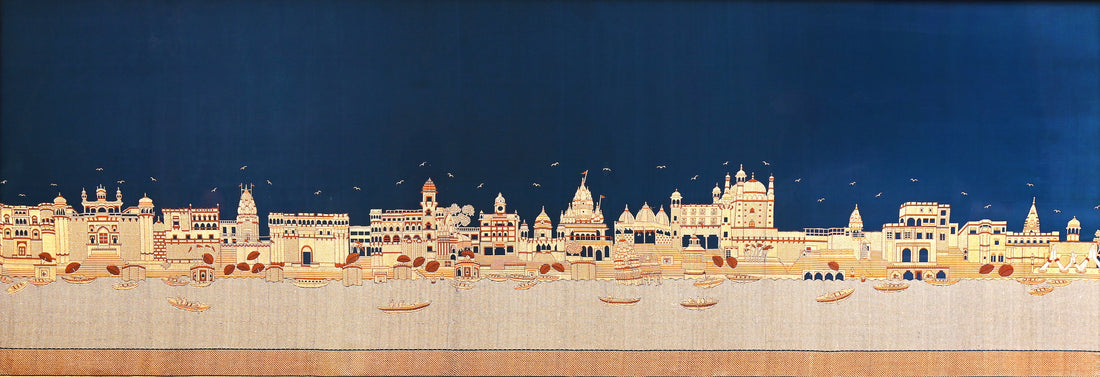
THE SHILP GALLERY AT NEW PARLIAMENT HOUSE, INDIA
Text by Brinda Gill
On 28 May 2023, Shri Narendra D Modi, the Indian Prime Minister inaugurated the new Parliament of India building in the heart of New Delhi, the capital of India. The monumental, triangular-shaped complex is located next to the old circular Parliament House constructed in 1927.
The new Parliament building integrates Indian ethos in its architecture and architectural details, and in displays throughout the complex. It has been constructed with materials sourced from across the country.
Within the new Parliament House is the Shilp Deergha, a gallery that celebrates culture, craft and communities; shilp is a Hindi word for craft. There are eight installations, handcrafted employing different traditional craft techniques, on display at the Ship Gallery. These are named Gyan (knowledge), Prakriti (nature), Aastha (faith), Ullas (joyfulness), Parv (festival), Samrasta (harmony), Swavlamban (self-reliance) and Yatra (journey).
“The installations have been conceived as unique, contemporary interpretations of India’s historical, cultural and intellectual legacy; rooted deep in the past, yet reimagined in the present”, says Jaya Jaitly, Founder, Dastkari Haat Samiti, who designed the eight installations and worked with more than 300 artisans, over ten months to create the works. The well-experienced team of Dastkari Haat Samiti reached out to over 300 craftspeople, across India, for the project.
From textiles to paper craft, pottery, hand carved wooden blocks, metal craft, kavads that are multi-door mobile temples, and calligraphy, each installation portrays a particular traditional craft of India in a wonderful expression. For instance Aastha, a collection of pottery, is moulded from the clay of every state and Union Territory of India!
Among the eight installations are three textile works. One is ‘Ullas’ or joyfulness featuring two embroidered patchwork quilts. For the quilts, natural-dyed, hand-spun, hand-woven fabrics were carefully selected; they were cut into squares of a designated size; and embroidery threads to match the fabrics were procured. The fabrics and threads were then sent to 45 women/women’s groups and communities in locations, in fourteen states, that were identified specifically for this purpose. The fabric patches were embroidered following different styles including applique, patchwork, kasuti, phulkari, tilla, sujni, Rabari, Sodha, chikankari, Lambani and Chamba rumal embroidery.

“For Ullas, each woman was asked to express the happiness she feels, for instance, when she has a child, or the inherent joy of the many selfless wishes and sacrifices she makes for her children. We received over 170 pieces, of which 85 were carefully selected for quality, technique and overall colour aesthetic. Eventually, they were arranged together to form quilts with the largest variety of embroidery styles ever assembled into a textile art installation!” says Ms Jaitly of the work that was created by her and Purnima Rai, an architect and craft designer.
The second textile-based installation is `Swavalamban’ (self-reliance), a triptych of hand block-printed ajrakh with natural dyes, on hand-spun hand-woven cloth, to celebrate the charkha or spinning wheel and what it stands for in the context of India’s independence. The work is a collaboration between textile artist Shelly Jyoti and ajrakh artisans and embroiderers in Ajrakhpur, Gujarat.
This installation features different charkhas, hand block-printed in traditional ajrakh style, and embellished with tiny mirrors and zari work. The charkha symbolises unity, freedom and self-sufficiency. It is an enduring symbol of India’s freedom struggle when Indians were asked to spin and weave cloth as an act of self-reliance, instead of buying imported mill-made cloth.

Yatra, portrays the story of Varanasi, India’s fabled sacred city, through the finest handloom, metal thread embroidery and brass repousse. The centrepiece is an exquisite hand-woven textile artwork, of 96 inches, with no design repeat, which traces the city’s riverfront of temples, buildings and ghats that are broad steps leading to the holy River Ganga. This artwork is flanked by two metal repousse sculptural pieces, and has two hand-embroidered panels with Sanskrit text passages that encapsulate the spirit of the piece. Yatra was conceptualised by Jaya Jaitly and created by Ujjwal Khanna of Tilfi with weavers and brass workers in Varanasi.
In their conceptualisation and creation, these three textile works, and the other five craft-based works, convey India’s unique living textile traditions and craft skills that are deeply roots in the past yet dynamic. Hand crafted in the ethos of the impressive new Parliament House, they embody the culture, pride and spirit of the nation.
Images Courtesy of Dastkari Haat Samiti.
Find out more:
Contact Jaya Jaitly: jayajaitly2017@gmail.com
Parliament of India website: sansadkikala.ignca.gov.in

1 comment
Amazing and very beautiful thoughts and works.